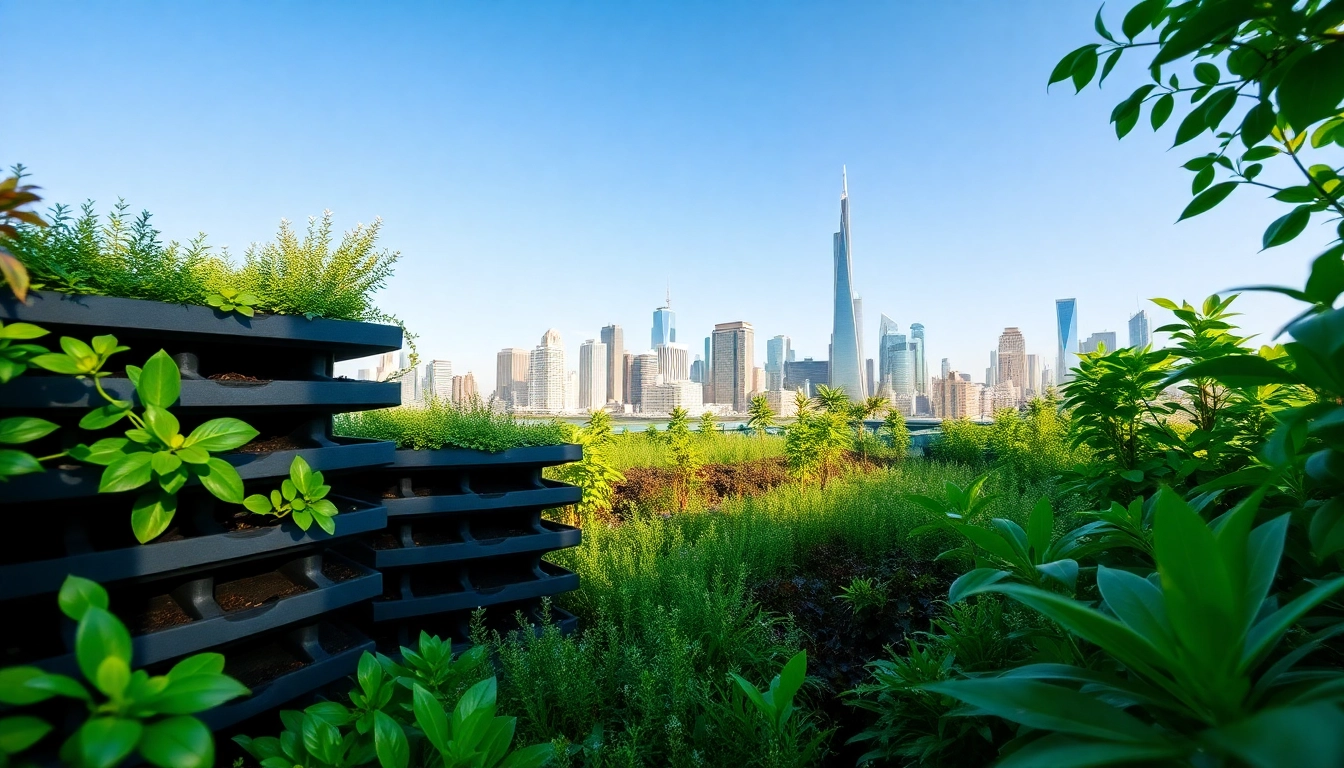
Understanding Green Roof Modules and Their Benefits
Definition and Overview
Green Roof Modules are engineered systems that allow for the integration of vegetation onto rooftops, effectively transforming typically unused space into living landscapes. These modules provide a structured way to support growing plants while addressing various urban environmental challenges. As cities continue to grow, the adoption of innovative technologies like Green Roof Modules is becoming increasingly important for creating sustainable living environments.
Environmental Advantages
Integrating Green Roof Modules into urban infrastructure yields numerous environmental benefits. They play a crucial role in reducing the urban heat island effect, which occurs when urban areas experience significantly higher temperatures than their rural surroundings due to human activities. By increasing vegetation, green roofs can lower surrounding temperatures, providing cooling benefits to buildings and the environment.
Moreover, Green Roof Modules enhance biodiversity by creating habitats for a range of wildlife, including birds and pollinators. This contributes positively to urban ecology by supporting local ecosystems. The presence of vegetation also aids in improving air quality, as plants filter pollutants and produce oxygen, leading to healthier urban living conditions.
Additionally, green roofs contribute to stormwater management. They absorb rainwater, reducing runoff and alleviating pressure on urban drainage systems. This can mitigate flooding during heavy rains while also improving water quality by filtering pollutants before water enters drainage systems.
Economic Impact on Urban Areas
The economic implications of adopting Green Roof Modules are significant. While the initial installation costs may be higher compared to traditional roofing systems, the long-term savings can be substantial. Green roofs reduce energy consumption by enhancing insulation. The vegetation on a green roof can keep buildings cooler in summer and warmer in winter, leading to decreased heating and cooling costs.
Furthermore, the installation of Green Roof Modules has been shown to improve property values. Properties with green roofs can command higher rental and sale prices due to their enhanced aesthetic appeal and environmental benefits. These roofs also help landowners comply with increasingly stringent building codes regarding sustainability and energy efficiency, which benefits both tenants and property owners alike.
Moreover, green roofs can create new job opportunities in landscape maintenance and installation, contributing to local economies. The demand for sustainable construction and green technologies continues to rise, providing further economic incentives for adopting Green Roof Modules in urban environments.
Components of Green Roof Modules
Material Choices for Durability
When selecting materials for Green Roof Modules, durability and longevity are paramount. Common materials include lightweight soils, geotextiles, and drainage mats that allow for efficient water management and plant growth. High-quality waterproof membranes are also essential to protect building structures from water damage.
Another critical component is the structural support frame of the module, which must be robust yet lightweight. This balance ensures that the module can support plant weight without compromising the building’s structural integrity. The chosen materials must also resist degradation from UV exposure and weather conditions, further extending the lifespan of the modules.
Plant Selection for Optimal Growth
The success of Green Roof Modules heavily relies on the selection of appropriate plant species. Ideally, plants should be native species that are well-adapted to local climates and require minimal maintenance. Drought-resistant plants such as sedums, herbs, and grasses are particularly popular due to their resilience and ability to thrive in the challenging rooftop environment.
Additionally, plants should be selected based on their growth patterns and aesthetic qualities. A diverse range of plant types not only creates visual interest but also enhances the ecological benefits of the green roof by supporting various wildlife. Including flowering plants can attract pollinators, while deeper-rooted species can aid in water retention.
Water Management Systems
Efficient water management is crucial for the longevity and health of Green Roof Modules. A well-designed module incorporates a drainage layer to prevent waterlogging, maintaining optimal moisture levels for plant growth. Additionally, integrate a water retention layer that can store excess rainwater for dry periods. This system promotes sustainable water use while ensuring that plants have adequate hydration.
Implementing irrigation systems can also facilitate plant health, especially during prolonged dry spells. Drip irrigation systems are a popular choice as they deliver water directly to plant roots, minimizing waste. Smart irrigation technology that adjusts water usage based on weather conditions can further enhance water efficiency.
Installation Process of Green Roof Modules
Site Assessment and Preparation
The initial step in installing Green Roof Modules is a thorough site assessment. This process evaluates factors such as roof structural integrity, load-bearing capacity, and exposure to sunlight and wind. These properties will determine the type and depth of modules that can be installed effectively.
Next, preparing the site involves cleaning the existing roof surface, removing any debris, and ensuring that the waterproof membrane is intact. If necessary, reinforcing the structural components of the building should be considered before moving forward with the installation.
Step-by-Step Installation Guide
Installing Green Roof Modules typically follows a systematic process:
- Install the waterproof membrane: Ensuring a secure, watertight base is critical to prevent leaks and protect the underlying structure.
- Lay the root barrier: This layer prevents roots from penetrating the membrane while allowing for water and nutrients to pass through.
- Add a drainage layer: This layer facilitates the movement of excess water away from the root zone, preventing water accumulation.
- Incorporate water retention and filtration layers: These layers enhance moisture retention while filtering rainwater as it drains, allowing for gradual absorption by the plants.
- Install the growing medium: Lightweight soil specific to green roofs is applied, typically to a depth of 4 to 6 inches, supporting successful plant growth.
- Add plant modules: Depending on the design, plant modules can be placed directly on the growing medium, ensuring proper spacing for optimal growth.
- Integrate an irrigation system: This optional step can help maintain appropriate moisture levels, particularly during dry spells.
Common Challenges and Solutions
While installing Green Roof Modules can enhance urban environments, several common challenges arise. One major issue is ensuring structural adequacy; roofs must support the added weight of soil and vegetation. Engaging with structural engineers during planning and installation can mitigate these risks.
Water management can also pose challenges. If the drainage system is improperly designed, it could lead to water accumulation, harming plant health. Therefore, integrating well-designed drainage and filtration systems into the installation process is vital.
Additionally, establishing a diverse plant palette may involve challenges related to plant compatibility and growth rates. Thorough research and possibly enlisting a landscape architect’s expertise can help inform the best mix of plants for optimal performance and visual appeal.
Maintenance Best Practices for Green Roof Modules
Routine Inspection Procedures
Regular maintenance is essential for the longevity and health of Green Roof Modules. A comprehensive inspection schedule should include checking the integrity of the waterproof membrane, looking for signs of water pooling or drainage issues, and assessing plant health.
Inspecting plant growth, soil moisture levels, and any invasive species should occur at least biannually. Implementing a checklist can assist in ensuring all vital maintenance aspects are addressed during each visit.
Watering and Fertilization Strategies
Effective watering practices are vital, especially during the establishment phase of plants. While established green roofs may require less frequent watering, ongoing monitoring of soil moisture is necessary to adjust irrigation practices accordingly. Using organic fertilizers can support healthy plant growth while reducing harm to the environment.
Moreover, selecting slow-release fertilizers specifically designed for green roofs can provide a steady supply of nutrients over time, minimizing the risk of nutrient runoff while supporting plant health.
Seasonal Care Tips
Each season presents unique challenges and opportunities for maintenance. In spring, it is crucial to assess plant health and encourage new growth by removing any dead plant material. Summer maintenance may involve more frequent watering and monitoring plant heat stress.
Autumn signifies a time for fall cleanup, where fallen leaves should be removed to prevent mold or fungal issues. Winter requires care as well; ensuring plants are adequately insulated from harsh weather can support longevity. This may involve adding additional mulch or protective layering around sensitive species.
Evaluating the Performance of Green Roof Modules
Key Metrics to Monitor
Evaluating the performance of Green Roof Modules involves monitoring several key metrics to gauge their effectiveness. Some critical indicators include:
- Plant health: Monitoring growth rates and overall health helps ensure vegetation thrives.
- Soil moisture levels: Assessing retention and drainage capabilities to prevent flooding and ensure hydration.
- Energy savings: Tracking reductions in heating and cooling costs post-installation.
- Rainwater capture: Measuring the amount of rainwater retained, thus evaluating the effectiveness in stormwater management.
Case Studies of Successful Implementations
Numerous cities around the world have successfully implemented Green Roof Modules, reaping their environmental and economic benefits. For instance, a notable case in Toronto showcased the municipal government promoting green roofs that led to enhanced biodiversity in urban spaces.
Another example from Chicago illustrated significant energy efficiency gains in commercial buildings utilizing green roofs, showcasing a remarkable return on investment within a few years. These examples underscore the transformative potential of integrating Green Roof Modules into urban landscapes.
Future Trends and Innovations
The future of Green Roof Modules is characterized by continued evolution and innovation. Advancements in technology are paving the way for improved materials and installation techniques. Smart technology integration, such as soil moisture sensors and automated irrigation systems, can optimize plant health while simplifying maintenance requirements.
Moreover, the emphasis on sustainability will continue to guide the development of greener roofing systems. Innovative designs that promote biodiversity and include edible plants are becoming intersectional solutions for urban agriculture while facilitating civic engagement and education.





